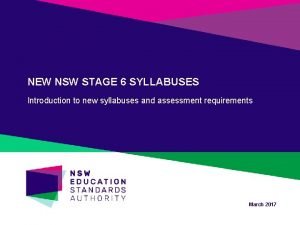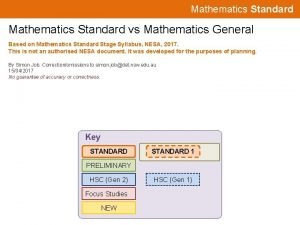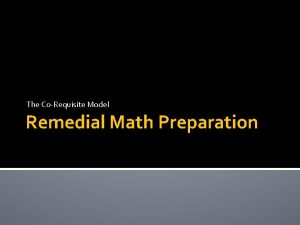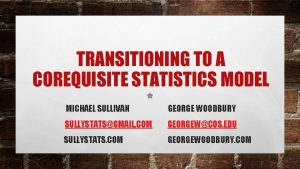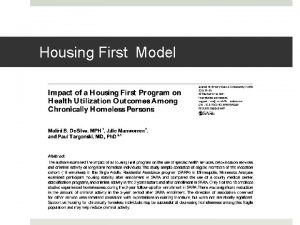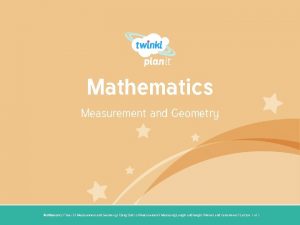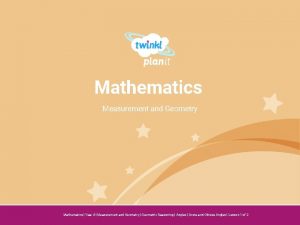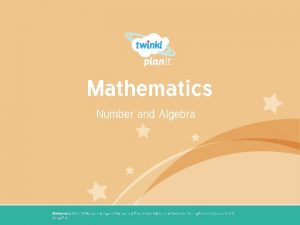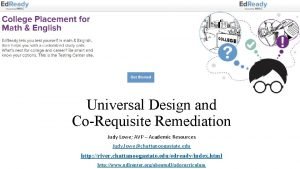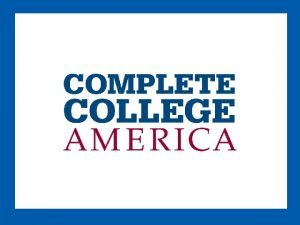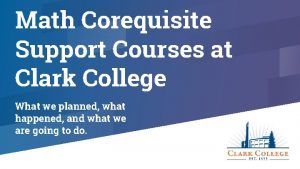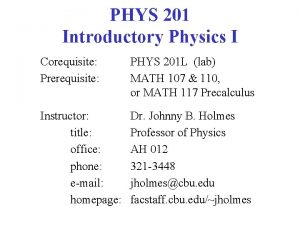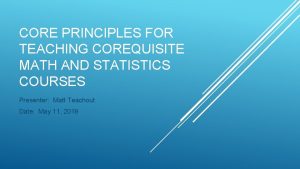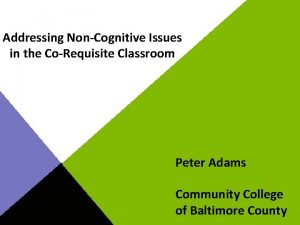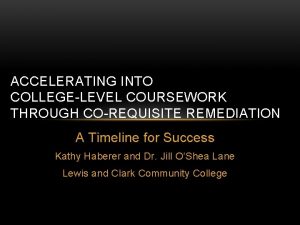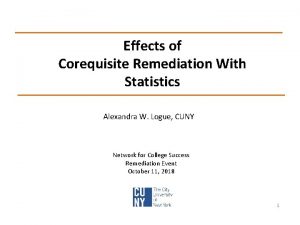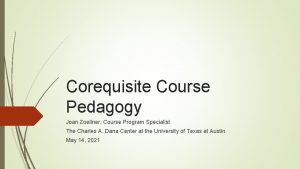A CoRequisite Model for First Year Mathematics The







































- Slides: 39

A Co-Requisite Model for First Year Mathematics The Community College Conference on Learning Assessment

Presentation Outline A Little Bit of Context • History of developmental education in Tennessee • Glossary Preliminary Results • Comparison of two cohorts at Pellissippi State, before and after co-requisite remediation Course Logistics • Scheduling, advising, enrollment, and progression Deep Dive into Curriculum • How the course content is structured and taught at Pellissippi State Wrap-Up • Questions and discussion

Developmental Education in Tennessee A Brief History

Previous Developmental Education Model (2005 – 2010) • All developmental coursework (mathematics, writing, and reading) could be completed in one academic semester • Modular – students placed based on ACT and secondary, inhouse testing at the College • Five mathematics competencies, two writing competencies, two reading competencies • Technology-centered – students were able to self-pace through content • Compartmentalized – distinct academic departments for college-level and developmental disciplines

Complete College Tennessee Act (2010 – today) • Established the reform agenda for public education in the state: • Universal transfer and articulation pathways between state universities and community colleges • Outcomes-based, or Quality Assurance funding formula developed for each school • State universities are no longer allowed to charge tuition for developmental courses

What is Co-Requisite Remediation? Developmental content is taught concurrently with a paired college-level course An acceleration strategy for developmental students Co-Requisite Remediation Implemented with developmental mathematics, writing, and reading Pathway focused: shortening time and reducing cost for a degree or credential

TBR Mandate for Mathematics Co-requisite remediation: The co-requisite experience will serve the dual purpose of supporting and illuminating the skills and concepts of the college-level credit bearing course while also providing instruction for students to remediate those mathematics developmental competencies in which they have a deficiency.

Preliminary Results and Success Rates Mathematics courses only

About Us: Pellissippi State Community College • Knoxville, TN – five urban and suburban campuses • First time freshman • 10, 244 students (Fall 2016) • However (Fall 2013): • 50% full-time enrollment • 3 year graduation rate – 25. 4% (2013 -2016 cohort) • ~20 mean composite ACT score • 67% required to take at least one developmental course • 61% enrolled in at least one developmental course

A comparison of two cohorts over three academic semesters Fall 2014 – Fall 2015 – Fall 2016 • Before implementation of mandatory co-requisite remediation • After implementation of mandatory co -requisite remediation • First-time freshmen only • 1332 students (62. 5%) required a developmental math course • 1470 students (59. 6%) required a developmental math course

COMPARISON: BEFORE/AFTER CO-REQUISITE Completed at least 1 College-level math course Did not complete a College-level math course 120% College-Level Course Completion • Fall 2014 cohort • • 41. 2% completed Fall 2015 cohort • 54. 8% completed 100% 80% 783 664 60% 40% 20% 549 806 0% Fall 2014 Cohort Fall 2015 Cohort

COMPARISON: BEFORE/AFTER CO-REQUISITE Fall 2014 600 College-level math courses completed Fall 2015 535 500 400 361 300 192 200 141 100 43 71 4 8 0 1 class 2 classes 3 classes 4 classes

Other Demographics Fall 2014 cohort Fall 2015 cohort Minority 29. 8% 49. 4% Adult 35. 9% 48. 7% First gen 38. 5% 52. 0% • Percentage of each cohort that successfully completed at least one college-level math course in three semesters • Definitions for demographic group • Adult – over 24 years • First generation – self-identified

Co-Requisite Course Logistics

PSCC Mathematics Courses Co-Requisite Course College Level Course MATH 0010 (2 hrs) MATH 1010 (3 hrs) Survey of Mathematical Principles Mathematics for General Studies MATH 0530 (2 hrs) MATH 1530 (3 hrs) Principles of Statistics Introductory Statistics MATH 0030 (2 hrs) MATH 1030 (3 hrs) College Mathematics Principles Introduction to College Mathematics All three co-requisite courses have a college-level reading requirement.

General Education Courses – MATH 0010/1010 and MATH 0530/1530 • “Blended populations” courses: • Co-requisite students meet with college-level students for the college-level portion of the course (MATH 1010, MATH 1530). • Fosters learning communities and a sense of belonging among traditionally excluded students.

Pre-STEM Course – MATH 0030/1030 • Not a “blended populations” course: • Each section of 1030 is either entirely co-requisite students or entirely college-level (19 -20 ACT) students • Sequential nature of intermediate algebra topics did not lend itself as easily to a “just-in-time” approach.

Placement – College algebra is not the default. MATH 0030/1030 MATH 0530/1530 STEM Social Sciences MATH 0010/1010 Liberal Arts Business (terminal) Business (transfer) Education Engineering technology Nursing Students needing further preparation

Weekly Course Contact Hours Face-to-Face College-level MATH 0030/1030 Face-to-Face Co-Requisite Mandatory Lab Hours* 5 hours MATH 0010/1010 3 hours 2 hours MATH 0530/1530 4 hours 1 hour 2 hours *Lab hours are completed in the Academic Support Center and tracked via scanning of the student ID card.

Instructional Staffing • The same instructor teaches both the co-requisite and college-level courses • Both full-time and adjunct faculty teach co-requisite sections • Faculty load hour calculation: • (contact hours + credit hours)/2 = 5 load hours for faculty

Course Completion Pass Co-Requisite course Fail Co-Requisite course Pass College-level course Student receives passing grades and credit for both courses. Competencies are marked as “completed” Student receives failing grade for corequisite; passing grade for college-level. Competencies are marked as “satisfied” Fail College-level course Student may re-enroll in the college-level course, without the corequisite course. Competencies are marked as “completed” Student must re-enroll in a corequisite-paired course.

Co-Requisite Curriculum

TBR Mathematics Learning Support Curriculum Develop study skills for success Communicate mathematically Be problem solvers Develop mathematical connections

Curriculum Competency Points Real number sense and operations Operations with algebraic expressions Analyze graphs Solve Equations Critical thinking and making mathematical connections

Instructional continuity Key Elements of PSCC Co-Requisite Model Tutoring/required lab hours Competencies in context Customized support text Project-based learning

Competencies in Context • Co-requisite coursework is mainly delivered using an online software program tied to the college-level course textbook. • Instructors on the co-requisite committees wrote and developed the majority of assignments online • Each co-requisite assignment question is written to assess the underlying developmental skill, while being framed using vocabulary from the college-level course • This creates a “seamless” feel for students, as all learning objectives are in support of the college-level course

Our curriculum team mapped competency points to student learning outcomes in the college-level course. Interpret numerical data as frequencies, ratios and percentages Calculate measures of center and variation using formulas and technology • MLS 1. 2 – perform operations with rational numbers • MLS 1. 5 – write and compare numbers in standard and scientific notation • MLS 1. 1 – apply the order of operations to evaluate expressions • MLS 2. 2 – evaluate algebraic expressions when given values for the variables • MLS 1. 3 – identify and calculate with irrational numbers

Customized Support Text • However, publishers did not provide texts that supported competencies in context for the co-requisite course • We wanted to avoid “pancaking” two disparate texts • Co-requisite committees wrote support texts for the two general education corequisite courses, MATH 0530 and MATH 0010. • Provided instructional content as well as examples and practice exercises

Competencies in context Area and perimeter of rectangles, triangles, and circles and probability

Competencies in context Writing inequality and probability statements

Competencies in Context Order of operations in financial formulas

• Used to assess the fifth competency point of making mathematical connections Project-Based Learning Fostering critical thinking in general education mathematics courses • Semester-long, thematic experiences in both general education math courses • MATH 1010 Project areas include: • Logic • Personal Finance • Probability and Statistics • Algebraic Modeling and Geometry • MATH 1530 Projects work with LARGE datasets and require the use of technology for analysis

Consumer Math: Home Sweet Home Most Americans aspire to own their own home at some point in their lives. The choice of a home rests on many factors, almost all of them financial. In this project many aspects of home buying will be examined and the student is encouraged to make realistic choices at every step. • Task 1: Answer the following questions and then research to determine a reasonable base salary for your future. • • What is your chosen career field or job? In which state and city do you intend to live? What is the beginning salary for a person in this field? State the source for the information on salary • Task 2: Find an advertisement for a house for sale using real estate booklets (available at banks, groceries, etc. ) or online (www. zillow. com). You will need to attach the information about your selected house to this project.

Home Geometry Task 1: • Compute the total square footage including the attached porch. • What is the square footage of areas that are heated and cooled? Task 2: • The furnace you are considering will heat up to 10, 000 cubic feet. Will this furnace be adequate to heat your home? Assume that you have 9 foot ceilings throughout the house and show all the calculations you made in order to answer this question.

Statistics Capstone Project Datasets • Youth Smoking • Police Involved Deaths • Discrimination in Hiring • Careers • Appalachia • US Presidents • United States of Appalachia common book experience • Global Terrorism

Youth Smoking Preliminary Discussion Questions: • What conjectures (educated guesses) could be made about the relationship between smoking and FEV? • What is the difference between “average” and “normal range”? • Why is FEV a good variable to measure the effects of smoking on lung function?

Youth Smoking Analysis Task 4: Stat. Disk is able to produce side-byside boxplots to facilitate comparison of data. This graph shows that, for our data set, the forced expiratory volume of the smokers was on average greater than the FEV for nonsmokers. Does this observation make sense? How can you explain this result?

Discrimination in Hiring Analysis One way to examine discrimination data is to analyze the relationship between variables. In the Ricci case, we want to look at the possible relationship between whether or not a candidate passed their exam and their race. Task 1: Use Stat. Disk to create a contingency table for the Lieutenant’s exam. Fill in the table below: Task 2: Perform the chi-squared independence test for the lieutenant’s position. Insert the results below. Can we conclude that the lieutenant exam results are independent of race? What does this imply about fairness in the promotion exam? Pass Fail Black 6 13 Hispanic 3 12 White 25 18

Wrap Up – Questions? Shareables? • Feel free to email us! • Brittany L. Mosby, blmosby@pstcc. edu • Sue Ann Jones Dobbyn, sadobbyn@pstcc. edu
 English life skills stage 6
English life skills stage 6 Year 11 mathematics standard
Year 11 mathematics standard Leaving primary school poem
Leaving primary school poem Iso 22301 utbildning
Iso 22301 utbildning Novell typiska drag
Novell typiska drag Nationell inriktning för artificiell intelligens
Nationell inriktning för artificiell intelligens Returpilarna
Returpilarna Varför kallas perioden 1918-1939 för mellankrigstiden?
Varför kallas perioden 1918-1939 för mellankrigstiden? En lathund för arbete med kontinuitetshantering
En lathund för arbete med kontinuitetshantering Kassaregister ideell förening
Kassaregister ideell förening Tidböcker
Tidböcker Anatomi organ reproduksi
Anatomi organ reproduksi Densitet vatten
Densitet vatten Datorkunskap för nybörjare
Datorkunskap för nybörjare Boverket ka
Boverket ka Debattartikel mall
Debattartikel mall Delegerande ledarstil
Delegerande ledarstil Nyckelkompetenser för livslångt lärande
Nyckelkompetenser för livslångt lärande Påbyggnader för flakfordon
Påbyggnader för flakfordon Formel för lufttryck
Formel för lufttryck Svenskt ramverk för digital samverkan
Svenskt ramverk för digital samverkan Lyckans minut erik lindorm analys
Lyckans minut erik lindorm analys Presentera för publik crossboss
Presentera för publik crossboss Teckenspråk minoritetsspråk argument
Teckenspråk minoritetsspråk argument Kanaans land
Kanaans land Klassificeringsstruktur för kommunala verksamheter
Klassificeringsstruktur för kommunala verksamheter Fimbrietratt
Fimbrietratt Claes martinsson
Claes martinsson Cks
Cks Byggprocessen steg för steg
Byggprocessen steg för steg Mat för idrottare
Mat för idrottare Verktyg för automatisering av utbetalningar
Verktyg för automatisering av utbetalningar Rutin för avvikelsehantering
Rutin för avvikelsehantering Smärtskolan kunskap för livet
Smärtskolan kunskap för livet Ministerstyre för och nackdelar
Ministerstyre för och nackdelar Tack för att ni har lyssnat
Tack för att ni har lyssnat Hur ser ett referat ut
Hur ser ett referat ut Redogör för vad psykologi är
Redogör för vad psykologi är Matematisk modellering eksempel
Matematisk modellering eksempel Atmosfr
Atmosfr
